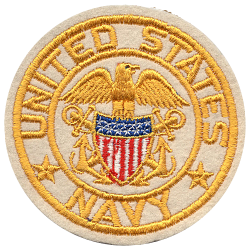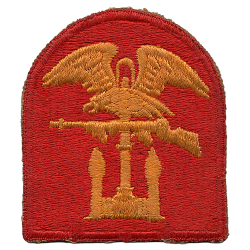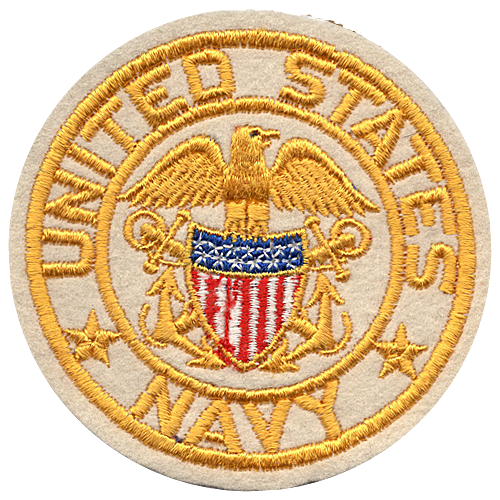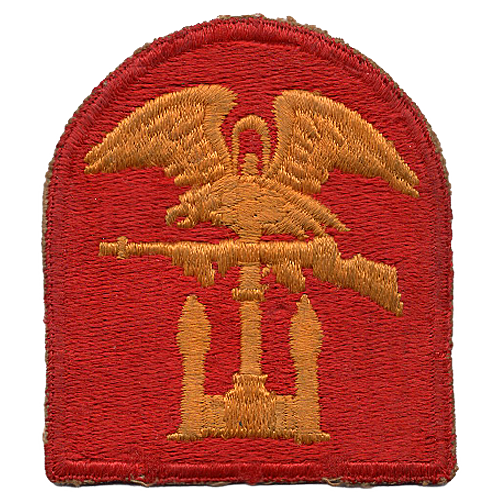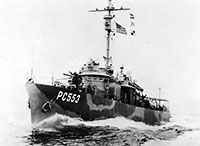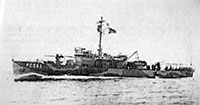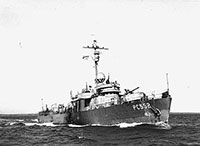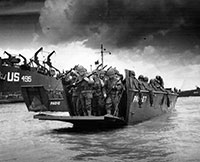April 28th, 1944, a convoy of 8 LST’s were holding a simulated invasion exercise called “Exercise Tiger”, when they were attacked by 9 German E-Boats (PT Boats) in Lyme Bay, between Portland and Brixham. Of the 3 LST’s torpedoed, two sank and one managed to limp back to the beach. The loss of life by the Army and the Navy was very great, but the incident was given the “silent treatment” by orders threatening court marshal to anyone who spoke up about the incident (This news would not reappear in any way until 1987 when a memorial service was held in England to dedicate a memorial to those missing men.) This episode brought the war closer to us and made us aware of some of the perils of war. Yet, we were young and tended to have a cavalier attitude to it all. We continued our troop movement exercises with no apparent problems, - everything was just another drill.
On May 24th, I found that we were topping-off our water and fuel tanks very frequently. This change in action set my mind to wondering. May 25th, we moved the ship in to Hard Ferry Dock, Plymouth Harbor, to begin loading army supplies, but rather casually. On May 28th, a special messenger with an armed guard arrived, and brought secret material aboard to the captain. May 31st, all sorts of army equipment started to move aboard, more deliberate now and with special care. Army soldiers of the First Infantry Division, veterans of the war in the Mediterranean, and also known as the Big Red Division, came on board with their gear. This didn’t look like any normal exercise.
June 1st, medical and gas decontamination equipment came on board. Word was passed that the ship was “sealed” – no one on and no one off anymore. June 2nd, small boat medical supplies and food supplies came aboard, - a Catholic Priest came aboard to hear confessions. June 4th, the boat, KBS Watchword, came alongside and attached a barrage balloon to a winch on our deck, and then left. Mass was held aboard ship and all soldiers and sailors attended, regardless of religious preferences. Orders of the impending action were posted on the ships bulletin boards, - this was it – no more practice sessions. June 5th, we got underway at 3 AM, raised our barrage balloon to 1000 feet, and slowly moved out to gain our position in the forming convoy. By 12 noon, the convoy was stopped to allow the battleships, cruisers and destroyers to pass in a column on our Port side. We moved ever so slowly fighting the rough seas, - sort of just biding our time. We moved toward Northern France at 1/3 speed, trying to time our arrival with first light and staying in the assigned lanes, that were cleared of mines by the minesweepers. The small boat crews were given a separate orientation session so as to re-enforce their objectives and destinations. It was then we found out that we were to hit Omaha beach in Normandy, at a place that would be known as Easy Red, - a bad misnomer, if ever there was one. On the whole, the First Infantry Division, while veterans of fighting in the Mediterranean, seemed pretty cool and not excited by any ominous or foreboding stories of things to come in the invasion. This reassured us newcomers to the war. We relaxed.
This First Division brought out another story, - about venereal disease. The Navy preached to us constantly about the effects of venereal disease and the damned effect it could have on the crew and running of the ship. To counter this, they always pushed the use of condoms. The First Division army soldiers taught us new uses for these little rubber envelopes. They put them over the ends of their rifles to keep the elements out. They wrapped their watches and possessions in them to keep them waterproof. Even cigarettes were waterproofed in them. Learning from this, we waterproofed our wallets, pictures and anything else we wanted to preserve from water damage in case the ship should sink. At last we found a use for these troublemakers we carried. We moved along the coast of Southern England and then headed into the channel following the markers (lighted Dan buoys every mile) to a place called Picadilly Circus, - a 10 mile circle, free of mines, that branched off into 10 marked lanes to France. There were ten PC’s on station at Omaha beach, - another eight were at Utah. PC’s were 173 ft. miniature destroyer escorts that were mostly used for antisubmarine warfare. However, today, they were on station to guide the invading ships to their proper beaches.
PC-553 was on station for Easy Red Beach with PC-552 at Fox Green, both standing off about a mile and a half from the beach. We were heading for the beaches of Normandy – our landing site would be near the inland town of Colleville. The order of landing on Omaha Beach would be the LCVP’s (Landing Craft Vehicle/Personnel) with the infantry and engineers, followed by the LCI’s (Landing Craft Infantry) and LCT’s (Landing Craft Tank) followed by the LST’s (Landing Ship Tank) with their tanks and other armored support vehicles. The LST’s anchored off shore beyond the range of the coastal guns. At 630 AM, our 6 LCVP’s took the First Division Infantry into the beach. It was low tide, with tide coming in, and the soldiers had to cross 400 yd’s of open beach to reach any kind of shelter (at the seawall) from the machine guns and the dreadful accuracy of the German 75 and 88 mm. cannons. Then the mortar shells would rain down on them, - fired from the rear of the ridge. The toll was tremendous, and by mid-morning, some thought was given to taking the men back off the beach. The large ships continued to shell the bunkers of the enemy but without much success, - they were well entrenched. The enemy forces was suppose to contain old men and young boys making for an easy victory, - but a veteran force (352nd Div.) was moved into position weeks before the attack, - we had no way to counter the error.
German General Rommel had fortified the beaches with many mines, installed wood and steel obstacles in the water with mines attached to them from 490ft. out to about 200ft. from the beach edge and all under water at high tide. It would be no easy task avoiding them or clearing them out of the way. The obstacles and the mines caught many boats on their run into the beach.The bodies of the dead soldiers floated about in the water, almost impeding the advances of the other troops coming up behind them. Frustration began to set in as the hours passed by.
Finally, a destroyer, McCook, being frustrated by not being able to see the targets and realizing the problems that the soldiers were having on the beach, came in closer to the beach so that it’s 5” guns could be brought to bear at point blank range for more accuracy at the German fortifications. While they could not actually see the hidden gun emplacements, they watched and followed the direction of fire from the soldiers on the beach to the hidden gun emplacements and aimed accordingly. Their tenacity and accuracy did the trick, - other destroyers followed their example. It allowed soldiers to climb the bluffs and get behind the enemy fortifications and rout them out. This sounds simple, but the pain and suffering of the troops was overwhelming, losses were very great, - more than was anticipated. It’s hard to imagine the destruction that bullets and shells can do to the human body.
Because of the stiff defense put up by the enemy, our timetable was shot down and we just waited for the moment to be called in by the beach-master. Just before noon, the army was able to trickle up the slopes in between the draws and get off the beaches to start inland, - but the number of men was sparse and there was still no room for the armored equipment on the beaches. Jam-ups were everywhere. I should mention here that “draws” meant a gap or opening in the cliff that would permit a vehicle to leave the beach area by roadway and connect to roadways beyond. Omaha and Utah both had 4 draws each, but the Germans had blocked passage with huge concrete blocks and covered them with withering gunfire. Moving equipment to the beaches was stopped and only infantry were being off-loaded to push the enemy out so that we could get the area cleared and draws and roads passable.
It seemed that nothing was going according to plan. The high winds and tidal currents kept pushing the invading craft off course to different areas. Our view of the area, anchored two miles out, was far from perfect. Yet with binoculars, the terrain could be seen and the turmoil on the beach was clearly visible, - it was not a pretty sight. The high cliffs gave the enemy the advantage, - their guns, trained to cover the beaches, took a deadly toll of boats and men. What men did get on the beach, few had any equipment or guns, - they were dropped and discarded to allow them to swim to shore. The German 75mm, 88mm. and 105mm guns seem to know just where to shoot. A week later, while touring the sites, I saw why they were so accurate. Each pillbox had panoramic sketches of the ground features in front of them with listings below of the range and deflection for specific targets. It was like shooting goldfish in a barrel. Each gun was facing the beach at an angle so that the gun flashes were not visible to the sea, - but their cross firing left no stone unturned, - it was impregnable except from the rear. All gun mounts were connected to one another by underground tunnels. It was just a question of when their supplies and ammunition would run out.
By mid afternoon, more infantry had climbed to the top of the ridge and engaged the enemy in their fortresses and trenches. But the lobbing of shells from the rear still hampered the opening of the draw and roadway for any vehicles to assist them. The tide had risen fully at noon and was receding so that some of the engineers could remove the steel obstacles and mines from the shore beaching areas. By evening, more work had been accomplished thus clearing the beach areas so that the tanks and supporting vehicles could be unloaded and used in the advancement. Again the tide was returning but the way to the beach was a great deal clearer now. LST’s moved up to discharge their vehicles. LST 495 hit the beach at 1925 and started to unload. The tank deck was cleared. At 2330, we went to General Quarters again, - other ships and landing craft in the vicinity used anti-aircraft fire - three barrage balloons were shot down off our port bow. At midnight, we received 18 casualties aboard. We stayed on the beach overnight. In the morning we offloaded some 105 mm ammunition and took more casualties aboard. By 1400 we were backing off the beach and underway again, - only to anchor off shore. Our barrage balloon was removed and taken ashore by Army personnel in a small boat. At 1700, we started to unload the top deck vehicles on to a Rhino barge that tied up to our bow.
Of our 6 Higgins boats, only 2 returned and they were pretty badly damaged. The other 4 were ordered to help unload the larger ships of men. We would not see them or their crews again for a month. The crews ate, slept, and foraged for food and fuel wherever they could. Meanwhile, we fed and provided fuel and rest for other boats in the vicinity, - we were like a mother ship. Some small boats of other ships needed repairs so we lifted them up on our davits and made the necessary repairs and refueled them. Their crews, after being fed and rested, left to resume their work. We had anchored about 1 ½ miles off the town of Coleville. Finally, at 1400 on June 9th, we headed back to England in a convoy of ships. We carried 249 wounded G.I.’s and 6 wounded German prisoners. The Germans were kept in a separate compartment and guarded for both their sakes as well as ours. The G.I.’s were on stretches on the tank deck. While the 3 doctors did what they could for them, and the medics also assisted in caring for them as well, our crew spent their free time with the G.I’s seeing to their comfort and just keeping them company. Some guys just wanted to talk, others said nothing but smoked constantly. Each had their own problems and we tried to help in our own way to make life a bit easier for them, - they had been through hell. I had one man, from the 101st Airborne, offer me his broken sunglasses to repay for kindness I had shown him on our trip back to England. It was all he had left to offer, - I accepted to help ease his feelings.
We traveled to Portland Harbor with 8 LST’s in the convoy and arrived at 630 in the morning, - we anchored waiting our turn to unload. Here I was to be surprised. At 2000, my oldest brother came aboard and requested of the captain that I be allowed to visit with him overnight. Brother Bill, a Major with the Adjutant General Division was in charge of the 14th Port, and knew before hand of my coming. We toured Portland, Weymouth and Dorchester in his jeep before we bunked down in his quarters in Dorset. The next day we toured some more and visited a USO club. I met some of Bill’s English friends and had my share of questions asked of me. Before I returned (ship would be loaded and leaving on the morning of June 12th for the return trip to France), brother Bill set me up with two cartons, each carried a bottle of scotch wrapped in the local newspapers. One went to the skipper and the other disappeared into the engineering spaces. That was our first meeting since Bill left for the Army in February,1941. It was a great reunion. A second brother, Henry, was with the 82nd Airborne and would not be seen until wars end.
June 12th was the start of our shuttling men and machines to the coast of France, sometimes to Utah beach, and sometimes to Omaha. Our return trips to England found us with either a cargo of wounded or a cargo of German prisoners. On one such trip, we carried 903 German prisoners in our tank deck. Since I had to dip-stick tanks for measurements on the tank deck, I had frequent access to the prisoners area. I listened to their conversations about wondering what will happen to them. Once I spoke German to one of them, I was deluged with requests for information. They all seemed to be of the feeling that they, captured by Americans, would be sent to America to sit out the war. This was like a dream that was to be fulfilled. I burst their bubble saying that they would be interred by the British in England – a real downer to them. But they were out of the war and could now concentrate on eventually going home and picking up the pieces of their life again. They brought out pictures of their families and proudly showed off their offspring. They seemed as normal as any American G.I., showing off his pride in his family and wishing he was back with them. I suppose it’s the politicians that start the wars, but it’s the civilians that have to go and do the fighting and dying.
As for my speaking German, I was born and reared in a German household. My mother came from Germany in 1903 as a young girl, and worked as a domestic for an uncle in Jersey City who had a business and a family. My father was a merchant seaman, a boiler operator, and spent some time making trips across the Atlantic. They met in Hoboken and a courtship ensued. Married in 1909, they had one daughter and three sons. German was spoken at home until one started school, then English became the language used. Mom attended night school to learn English. In high school, I took German as a language course since it would be an easy course. Since then, I’ve used my German spasmodically and it has suffered from non-use. Now my grandsons, Nick and Andy are taking German as a high school subject, maybe that will revive my fluency with the language, - that would be nice.
LST-495 was laid down on 14 August 1943 at Evansville, Ind., by the Missouri Valley Bridge & Iron Co.; launched on 16 October 1943; sponsored by Mrs. Arthur L. Nunn; and commissioned on 23 December 1943. During World War II, LST-495 was assigned to the European theater and participated in the invasion of Normandy in June 1944 and the invasion of southern France in August and September that same year. She was then assigned to the Asiatic-Pacific theater and took part in the assault and occupation of Okinawa Gunto in April and June 1945. Following the war, LST-495 performed occupation duty in the Far East until late October 1945. Upon her return to the United States, she was decommissioned on 23 April 1946 and struck from the Navy list on 5 June 1946. On 8 April 1948, the ship was sold to Kaiser Co., Inc., of Seattle, Wash., and subsequently scrapped. LST-495 earned three battle stars for World War II service.
Richard V. Ehlert

